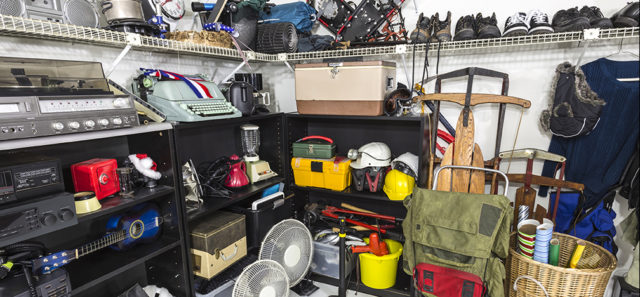Goods, goods everywhere: clothing, toys, games, books, magazines, appliances small and large, furniture, bedding, cars new and old, trucks, bicycles, tricycles, scooters, camping gear, boats, boat motors, fishing gear, sporting goods, old computers and printers, old TVs and radios, old record players and speakers, music CDs, LPs, cassettes, saved boxes, Christmas decorations, lawn mowers, art, clocks, luggage, toasters, waffle irons, irons, electric skillets, decks of cards, jigsaw puzzles, Monopoly games, photographs and photo albums, scrapbooks, saved letters, uniforms now too small, musical instruments, guns and ammo, tools, paint—some old and some good yet, broken down lawn mowers, you name it.
Time to downsize? Simply, it means reducing the things in your possession so that you occupy less space. The urge to downsize usually comes when moving to a smaller living space—from a house to apartment for example.
Having gone through the process several times myself, I can testify that following these guidelines can help:
- Start early.
- Plan to take several days, not just hours.
- Don’t start with the photos.
- Involve all inhabitants of the dwelling.
- Expect to make some mistakes.
- Maybe hire a professional downsizer, either to consult or do it all while you leave town.
What’s in your mind as to an overall policy may be the most useful operating rule of all. “Focus on what you’re taking with you–what you’re keeping–then leave everything else behind,” recommends for-hire organizer Emily Carroll, the owner of a small firm she calls Sorted Stones Home Organizing LLC.
Hiring such a firm to manage your downsizing project may be very useful. What you get is help with the decision to hold a sale, or not, sorting items into categories, pricing, and disposing of unsold items post-sale.
Emily was especially helpful to Laurie and Tim Melby, of Crystal, Minnesota, by conducting an “estate sale” needed to reduce sharply the amount of furniture, clothing, cooking equipment, and other household goods accumulated from merging two households into one. Says Laurie about Emily’s work, “She did much of the money-handling, and knew efficient ways to manage a sale. We paid her about half of our gross sales. She was well worth it.”
Remarked Emily, “It’s a joy to me to help bring order out of chaos. Often, my clients have had something big happen in their lives, followed by a cluttered household and eventually a need to return to order.”
Patty Hoge, 65, a resident of Cornerstone Assisted Living in Plymouth, Minnesota, a suburb of Minneapolis, needed to downsize when moving from a large apartment In Richfield, Minnesota. “I’m not a things person,” she said, “so downsizing wasn’t a major problem. I just need the brain space for something else.” A number of furniture antiques in her family’s possession, some for 50 years, were valuable, and in their early years her adult children showed no interest in owning them. Later they did, however, and some of the antiques found new family homes. Patty declined to pass on certain other antiques, indicating her enjoyment in having them nearby in her own living space, as enjoyable art. “I’m just not ready to part with them yet,” she said.
As to downsizing overall, she declared the basic guideline: “Anything that meant anything to me memory-wise, I took with me. None of the family-owned antiques were actually sold, rather they remained within the family.”
Also, I downsized beyond my need to do so. It was like a fresh start—I got myself some new living room furniture and a new bedroom set.”
Jan Brosen, also a resident of Cornerstone, at 62 is dealing with the early symptoms of what may be Alzheimer’s. A Lutheran pastor, she downsized significantly when moving to her present smaller quarters. “For me, all the books that I had were very important to me. They helped shape my perspective and my theology, and in a sense were my friends. It wasn’t easy to pare them down, but I knew when I did, others would enjoy them as well.” Similarly, her collections of beloved items, such as angels, were difficult to let go. But knowing that others would use them to help decorate their homes made downsizing a little easier.
That could be the most important takeaway on downsizing—that what you give away or sell is going to be enjoyed by someone else.









